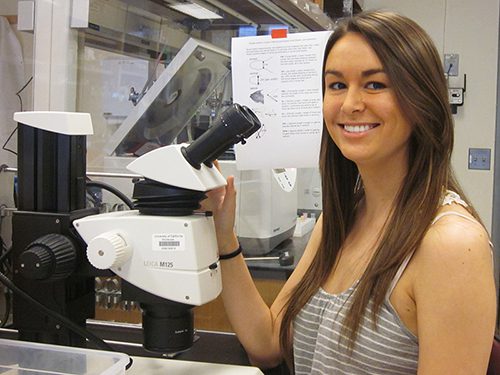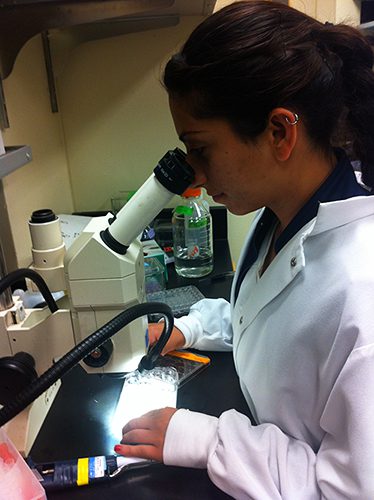Rachel Agoglia

Understanding the genetic mechanisms that underlie morphological evolution is a long-standing goal in biology. The threespine stickleback (Gasterosteus aculeatus) is an emerging model organism with features ideal for studying the molecular basis of morphological evolution. Several stickleback populations display evolved differences in tooth number, likely adaptive to match different diets. These differences in tooth number are largely controlled by a Quantitative Trait Locus (QTL), a genomic region controlling a quantitative trait. This QTL is located on chromosome 21 and contains an excellent candidate gene: Bone Morphogenetic Protein 6 (Bmp6). I […]
YeeAnn Chen

Cancer is a potent disease that occurs when cells acquire certain mutations that cause uncontrollable cell growth. MicroRNAs (miRNAs) are small non-coding RNAs that have been associated in cancer development. In our research, we specifically study the tumor suppressive effects of miRNAs on B cell lymphoma, a type of blood cancer in the lymph nodes. We have determined that the deletion of mir-34a or mir-34bc (tumor suppressive miRNAs) accelerate lyphomagenesis. More recently, it has been shown that there is a homologous cluster of miRNAs, the mir-449 family, suggesting similar functions. […]
Adam Krause

Recent evidence suggests that sleep and sleep loss have profound effects on emotional brain reactivity, especially for positive emotional experiences. As a consequence, sleep disruption may lead to detrimental risk taking and reward seeking. However, it remains unclear exactly what type of sleep helps reset the brains ability to appropriately react to rewarding experiences. I propose to test the hypothesis that a specific type of sleeprapid-eye movement (REM) sleep, and its associated electrical brain activityrestores the optimal next-day reactivity to rewarding, motivating experiences. I will therefore investigate whether the quantity […]
Eric Lu

Many eye diseases, such as diabetic retinopathy, age-related macular degeneration, and macular edema, are caused by the abnormal development of retinal vasculature. My project aims to better understand the signaling network that regulates this process by examining the function of two key molecules: Very LowDensity Lipoprotein Receptor (VLDLR) and Low Density Lipoprotein Related Protein 5 (LRP5). Previous studies have demonstrated that VLDLR promotes vessel growth while LRP5 inhibits it. Additional studies done by the Gong lab suggest that LRP5 plays a more dominant role in this process. In order to […]
Alina Boltunova

Emmetropization is a normal developmental process in which the eyes growth is regulated to achieve a match between eye length and its refractive power. It results in the reduction of refractive errors present at birth and has been observed in all animal species, including humans, studied thus far. The guinea pig is increasingly used to model myopia (near-sightedness), but there appear to be differences between guinea pig strains in their susceptibility to myopia-inducing stimuli. To understand the origin of these differences, I plan to compare the emmetropization of different strains […]
Angela DiRocco

Arboreal animals such as the Green Anole, Anolis carolinensis, must be able to manipulate aerial descent to reduce injury when dislodged from elevated habitats. To maintain controlled aerial descent, the anole must obtain a prone posture. Anoles have been known to correct orientation after dislodgement by use of their tails through either the conservation of momentum to induce roll or by lateral swings which alter yaw. While the mechanics behind yaw and roll alterations are understood, the extent to which an anole can correct pitch at high angles is not. […]
Mark Phuong

Species Distribution Models (SDMs) provide one of the only methods for projecting the future distribution of species and are increasingly used to prioritize conservation efforts. SDMs correlate species’ occurrence points with climatic variables (e.g., temperature and precipitation) to produce a distributional map of the climatic limits of a species. Genetic studies of geographic variation within species, or phylogeography, often uncover cryptic lineages that have remained evolutionarily isolated for thousands to millions of years. My research assesses how identifying cryptic diversity within species affects the predictions of SDMs. Faced with climate […]
Ben Reuveni

Human memory is characterized by multiple memory systems. Two of the most widely recognized of these are the procedural and declarative systems. My project extends a line of research aimed at exploring the interaction between these systems. Previous research using category learning paradigms widely thought to selectively tap either the procedural or declarative memory system has implied that these two systems compete for control of motor resources.For example, human participants usually perform poorly in category learning tasks in which optimal performance requires trial-by-trial switching between procedural and declarative strategies. My […]
Bhavi Vohra

I will use Transcription Activator-Like Effector Nucleases (TALEN) -mediated mutagenesis to determine the function of the RNA-binding protein tra2b and its role in alternative splicing during Xenopus tropicalis development. TALENs or Transcription Activator-Like Effector Nucleases, are artificial restriction enzymes that create double stranded breaks, inducing mutations in targeted loci. They can be engineered to target any DNA sequence and cause permanent changes in the genome. Alternative splicing and pre-mRNA processing is an important target for regulation of eukaryotic gene expression, which is what I am interested in studying.
Han Amy Li

This research attempts to determine how the circadian system controls the timing of ovulation, a requirement for successful reproduction. Initiation of ovulation requires a signal from the brain’s master clock, the suprachiasmatic nucleus (SCN). This signal’s necessity in most mammals, including humans, is apparent as disruptions in circadian rhythms lead to reproductive deficits. Currently, the neural pathways and neurochemical mechanisms by which the SCN triggers ovulation remain uncharacterized. Previous work indicates daily rhythms of GABA and kisspeptin, neurotransmitters that inhibit and stimulate ovulation, respectively, are crucial for reproductive maintenance. We […]